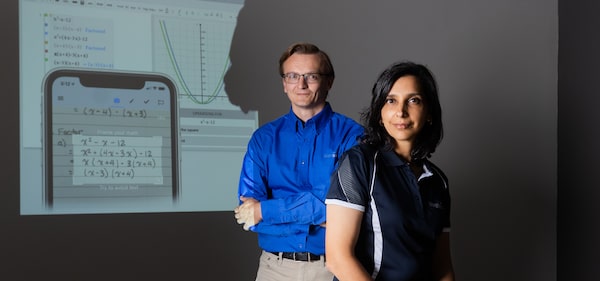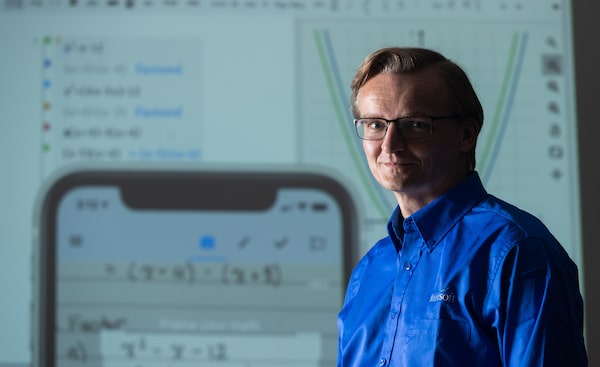
Laurent Bernardin, CEO of Maplesoft and Karishma Punwani, director of academic products, at the company's Waterloo headquarters on June 8, 2021. Maplesoft offers AI-backed technology that can help students solve math problems.Glenn Lowson/The Globe and Mail
Our brains have long relied on machines to help with mathematics – calculators being the most obvious example. But there’s a Canadian-made technology that’s helping students and researchers master math at a much higher level thanks to advances in artificial intelligence (AI).
Waterloo, Ont.-based Maplesoft offers AI-backed technology that can help students solve math problems, check their homework and explore graphs in 3-D within seconds. It’s more versatile than scientific calculators and arguably more fun.
“Our mission is to just make math more accessible,” says Karishma Punwani, Maplesoft’s director of academic products. “We want to change the way students view, learn and access math to help them see the awe in it.”
The Canadian-built technology isn’t only used in the classroom: Maplesoft’s software is also used by engineers and researchers at organizations such as Google, NASA, the Canadian Space Agency and research labs around the world.
“It’s software that can do any type of mathematics you can think of. It’s that powerful,” Ms. Punwani adds.
Canadian tech success story
Maplesoft is a homegrown technology success story most Canadians have never heard of.
Spun out of a startup venture at the University of Waterloo in the 1980s, the company has quietly become one of the world’s leading providers of mathematics software. Its founders were Waterloo computer sciences professors Keith Geddes and Gaston Gonnet, at the time part of the postsecondary institution’s Symbolic Computation Group, which focused on research and development of algorithms and related mathematics fundamental to the development of software used in areas such as engineering, economics and physics.
Maplesoft’s flagship product Maple features key building blocks developed by the group that today make it the world’s most powerful math engine, not only able to solve almost any math problem be it in calculus, physics or financial modelling. Maple helps learners and researchers – using 2- and 3-D visualizations and other interactive tools – gain insights into problems they would otherwise be unable to do as quickly, or at all.
More recently, Maplesoft launched two new products, Maple Calculator App and Maple Learn, for high-school and university students. Maple Calculator is a mobile app capable of understanding complex handwritten math equations and converting them into a digital format for Maple, or the company’s newest software, Maple Learn, launched in January. Maple Learn is an online version of Maple that Ms. Punwani says is geared to helping students from high school to second-year university.
Using inputs from Maple Calculator, Maple Learn can examine students’ work and tell them if they arrived at the correct answer. It can also show students when and where they’ve made an error and why.
It’s the kind of machine assistance many students could use in today’s virtual classroom environment where teachers aren’t always present. The company says the software isn’t intended to replace human teachers but is designed to emulate aspects of the human mind and combine those abilities with a computer’s prowess in making lightning-quick calculations.
“The educator will always be there,” she says, noting that the software’s beta version was sent to about 5,000 students and teachers who then suggested improvements prior to its release.
With Maple Learn, the AI-powered engine from Maple has been repurposed, Ms. Punwani adds, “with interfaces and workflows that are really intuitive and simple,” making it easier for teachers and learners to use.
The AI impact

When it comes to AI development, Canada 'punches above its weight globally' despite trailing China, Japan, the U.S. and others in private and public sector investment in AI, says Mr. Bernardin.Glenn Lowson/the globe and mail
Now a buzzword in any technology discussion, AI endeavours to do with computers what humans do exceptionally well: analyzing data and recognizing patterns to provide insights.
Only AI also harnesses the power of supercomputing, able to perform complex mathematical feats much faster than even the smartest human ever could.
AI has also become an increasingly big business. The global AI market is expected to hit US$267-billion by 2027, up from about US$27-billion today, according to a recent Fortune Business report, affecting every sector of the economy, from finance and manufacturing to health care and education.
When it comes to AI development, Canada “punches above its weight globally” despite trailing China, Japan, the U.S. and others in private- and public-sector investment in AI, says Maplesoft chief executive officer Laurent Bernardin.
Maplesoft has long been an AI leader in educational software; after being acquired by Japanese conglomerate Cybernet Systems Group in 2009, the company was able to achieve a greater global reach.
Today, Maple advanced math software is used by 95 per cent of the world’s technical universities, he says.
“Our technology has always incorporated artificial intelligence techniques, but 30 years ago, AI meant something very different from what it means today,” Mr. Bernardin says.
He says Maple’s early iterations relied on (and still do) heuristic principles – an early form of AI that solves problems more quickly when traditional methods are too slow, or don’t find an exact solution.
“But our technology has evolved with the very concept of what AI means and what it can do,” Mr. Bernardin says.
Today the company’s software, including Maple Learn and Maple Calculator, uses sophisticated innovations, referred to as machine and deep learning, that build on older ones involving heuristic algorithms.
These “AI tools” are made possible by the work of trailblazing Canadian data scientists such as the University of Toronto’s Geoffrey Hinton, Richard Sutton from the University of Alberta and Yoshua Bengio from the Université de Montréal, says Jeremy Shaki, CEO and co-founder of Lighthouse Labs.
These researchers aren’t affiliated with Maplesoft, but “they were at the forefront of solving the big AI problems” that made its software possible, says Mr. Shaki, with the Toronto-based provider of technology education involving AI-based tools.
For example, he says Mr. Hinton built pieces of AI that made Maplesoft viable as a company. He and Mr. Bengio were also recognized in 2018 for work that paved the way for computers to understand natural language, spoken or written.
While an incredibly complex undertaking, the tasks their work enables are intellectual feats most people would not consider all that mentally taxing.
As Mr. Bernardin explains: “If you multiply two big numbers together, 1,255 x 3,256, that’s something a human probably doesn’t do naturally but to a computer, that’s very easy.”
In contrast, a person can look at “2 + 5″ written on a piece of paper and easily solve the problem.
“But for a computer, that was really a tough problem up until now,” he notes, adding the software first had to be trained to recognize the phrase as a math equation to be solved.
“Today’s AI, however, can easily overcome these obstacles.”
Partly built on these discoveries, Maple Calculator uses an AI tool called optical character recognition, a form of machine learning, allowing it to read handwritten language.
“When our calculator tries to figure out from a picture of handwritten math … it does so by using millions of samples of handwritten mathematics it has seen before,” Mr. Bernardin adds.
When paired with Maple Learn, the calculator is a powerful math helper for students.
“A lot of times we hear from those age groups that ‘math is scary’ and ‘math is hard,’ ” Mr. Bernardin says.
That’s where a more complex machine learning – deep learning – comes into play. It not only points out what’s incorrect, but also suggests other math exercises to improve students’ understanding to avoid making the error again.
Offered online, Maple Learn is available wherever and whenever students need it, an increasingly sought-after characteristic as they learn from home.
Many could use the extra help too, as they often struggle with a subject ever more critical in an economy driven by technology.
“Fundamentally, we believe that math is very important in today’s world,” Mr. Bernardin says, noting its integral role in everything from developing the latest mobile apps to space exploration and the development of vaccines.
Yet Canadian students are falling behind other major economies when it comes to advanced math learning, a 2018 federal report found. Examining the performance of 15-year-olds’ math skills, a 2018 Council of Ministers of Education study revealed that Canada ranked highly among OECD (Organization for Economic Co-operation and Development) countries for basic numeracy, but trailed China, Singapore, Japan, the Netherlands and other countries in advanced mathematics.
Maple Learn and related technologies could help close that gap, acting as a bridge to more advanced mathematics education and related career opportunities, Ms. Punwani says.
Call it gateway software to hard math – if you will.
“It’s about replacing that feeling of ‘I hate math’ with ‘I can do this; I love math!’ ” she says. “At Maplesoft, that’s our mission.”